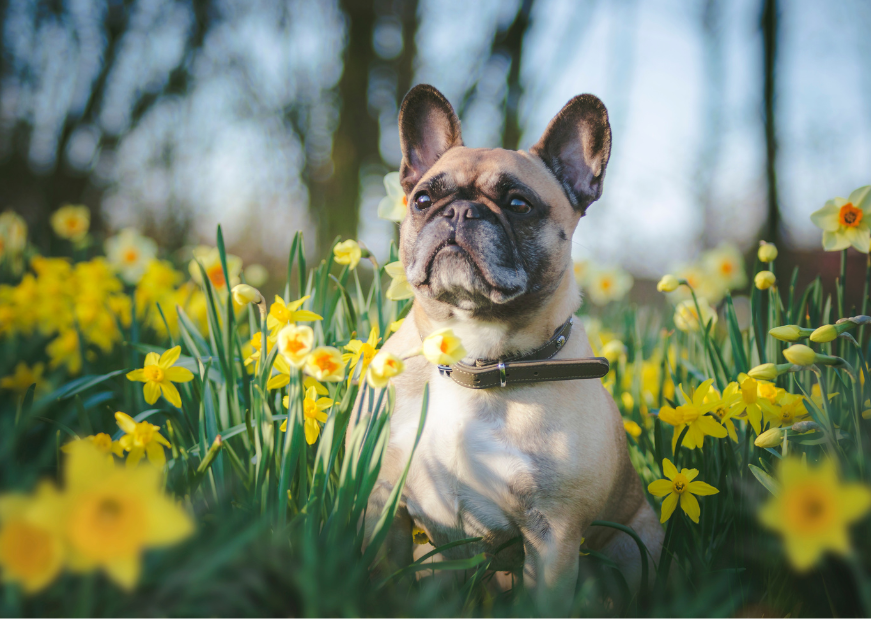SPRING FORWARD AND ENJOY THE NEW SEASON 🪻KNOW WHICH OF NATURE'S FLOWERS MAY HARM YOUR DOG 🪻

🪻Spring plants to be careful of:
Amaryllis - They can be found both indoors and outdoors, but all parts of the plant are poisonous to dogs and should always be kept out of reach.
Bluebells – All parts are poisonous, but in particular, the bulbs.
Daffodils/Narcissus – All parts are dangerous, including the vase water that daffodils have been sat in. Daffodils contain a toxic alkaloid called lycorine which is a powerful emetic; your dog may experience vomiting soon after ingestion.
Geraniums - All parts are dangerous. Most grow in the summer, but warm springs bring them to bloom early.
Hyacinths – Bulbs are the most dangerous part, being poisonous
Iris – All parts are poisonous, but the toxins are more concentrated in the bulb. (this includes the gladioli plant)
Lillies – All parts of the Lily are potentially poisonous, including the leaves and petals. The most dangerous lily plants are Asiatic, Day, Easter, Japanese and Tiger lilies.
Lily of the Valley – All parts are toxic and can cause digestive and cardiac disturbances. It’s worth noting the lily of valley of plant can grow amongst wild garlic, growing in its early stages it can mimic the garlic plant, which is a safe plant, the potent aroma of the wild garlic could also mask the bittersweet smell of the toxic alkaloids within the lily of the valley.
Ragwort - All parts of the ragwort plant are poisonous; this plant grows throughout till the autumn. Although ragwort poisoning is more common to horses and other herbivores, it can still occur to a curious dog.
Rhododendrons and azaleas - Classed as either rhododendron or azalea, this brightly coloured plant is highly poisonous to dogs. All parts of the rhododendron plant are toxic, and just eating a small amount can cause your dog to become very unwell. Smaller dogs and puppies are more likely to be affected seriously by rhododendron poisoning than larger dogs. In severe cases, rhododendron poisoning can be fatal.
Rhubarb - The leaves are poisonous.
Snowdrops - All parts are poisonous particularly the bulbs
Tulips - The bulbs are most toxic, but eating other parts of the tulip in quantity can also cause danger for our pets.
There are many other plants and bulbs that flower during spring, which are also poisonous to dogs. Those in bold are potentially fatal, so please take care to avoid these:
- Buttercups
- Crocuses
- Cyclamen (root)
- Elderberry
- Foxglove (leaves and seeds)
- Lupin (leaves, seeds)
- Onion (causes anaemia)
- Sweetpea (stem)
- Wild cherry tree (twigs and foliage)
- Yew (berries and foliage)
Spring is also a popular time to organise the garden ready for the new season, so if your dog is ‘helping’ you with the gardening, just be mindful of where they are digging, sniffing burying a toy or potentially nibbling.
If you’re thinking about heading out to the garden centre to buy some new plants for your freshly organised garden, don’t forget to check which plants are safe for dogs before you plant anything new.
🌿☠️ Here's our full list of plants poisonous to dogs ☠️🌿
You may not know that your dog has eaten a poisonous plant until they show symptoms. Getting to know the symptoms of plant poisoning can help you spot the signs quickly.
Symptoms of poisoning to look out for are:
- Disinterest in food
- Low energy or fatigue
- Confusion
- Shivering
- Unexplained bleeding
- Poor coordination
- Vomiting or Diarrhoea (especially if bits of chewed up plants are in it)
- Drinking or weeing more
- Rashes/Red Skin
- Mouth ulcers or pale gums
- Drooling
- Blood in stool
- Breathing difficulties
- Seizures or twitching
⚠️If you think your dog has been poisoned, contact your vet immediately⚠️
Don't wait for symptoms of poisoning to appear if you have seen your dog eat something they shouldn't.
Be aware that the symptoms your dog may display may differ based on the plant and the quantity.
If your dog is showing signs of poisoning, it’s also a good idea to make a note of the following:
- Details of anything you think your dog has eaten
- When they ate or drank it
- How much they have swallowed
- What symptoms they have been experiencing
🩺The sooner your dog is treated, the better their chance of recovery 🐶
Credit References: https://www.rffdmsuk.co.uk/blog/categories/flowers










